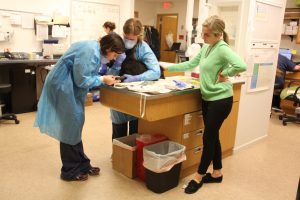Peoria clinic offers new hope for pets with cancer
By Holly Eitenmiller For Chronicle Media — January 30, 2017
Veterinarian Allison Book, right, observes as Certified Vet Technician Kelly Lewis, left, and Veterinarian Assistant Leah Richardson administer chemotherapy to Clementine, an 8-year-old Scottish Terrier diagnosed with Lymphocytic Sarcoma four months ago. (Photo by Holly Eitenmiller / for Chronicle Media)
In early October, Todd and Libby Heidt discovered lumps on their dog’s neck. Clementine, their 8-year-old Scottish Terrier, was diagnosed with Lymphocytic Sarcoma, an aggressive form of cancer.
She would only have survived 4-6 weeks without treatment had the Heidts not sought help through Peoria Area Veterinary Group. PAVG founder Dr. John W. Calhoun began operating the Peoria Area Veterinary Cancer Clinic in early 2016.
“We adopted her two years ago thinking we’d have eight years or more with her,” Libby said, while waiting for Clementine during a recent appointment at PAVG’s Peoria clinic. Before the cancer clinic opened in November, the Heidts drove to the University of Illinois Veterinary Treatment Teaching Hospital in Champaign.
Now, Dr. Allison Book rotates twice a month at the Peoria clinic, treating a growing number of patients for cancers, most commonly, the kind that has afflicted Clementine. Book said PAVG currently treats around 20 pets.
“An estimated 6 million dogs and nearly 6 million cats will be diagnosed with cancer this year. In many of these animals, the malignancy will look and behave much as it would in humans … spreading to the same organs,” according to Fetchacure.org
“We see a lot of soft cell tumors, spleen cancer, Osteosarcoma,” Book said. “Many of the cancers are common in humans, lots of parallels, so dogs are very important in cancer research.”
Animals, however, don’t often suffer from cancer treatments the way humans do. “In general, most cats and dogs don’t have serious changes in quality of life the way people do,” Book said.
The course of action most often involves first removing the cancer from the animal before administering chemotherapy, Book said. The remission rate, she said, is excellent, with 8-9 out of 10 patients seeing complete remission.

Kelly Lewis and Leah Richardson of Peoria Area Veterinary Group dress Clementine, a Scottish Terrier battling cancer. Clementine receives chemotherapy to treat her disease. (Photo by Holly Eitenmiller / for Chronicle Media)
“The trouble is the longevity. It’s rewarding to treat upfront, but relapse rates after a year are high,” Book explained. “Extending the life of the pet is the hard part, but we move forward with as much hope as possible.”
Extending the life of the pet, and increasing its quality of life is the predominant motivator in pet cancer practice, she said. Most clients spend around $3,000 for treatments that generally add a couple of years to their pet’s lifetime. Most cancer diagnoses occur in animals over the age of 8 and around 75 percent are dogs.
“Two extra years for a dog can mean they life out their life expectancies,” Book said. “Others look at treatment as a sort of hospice care, as a means to make their pet as comfortable as possible through steroids and pain meds.”
Pet cancer treatment isn’t exclusive to dogs and cats, she said. Book has also treated a parrot, a cougar, a cow and a chicken. “The chicken was someone’s pet,” she said. “We treated her for ovarian cancer.”
For the Heidts, Clementine’s outcome remains unknown. She currently is not in remission, and the couple have volleyed between various treatments to battle their dog’s illness.
But Clementine, who flounced merrily about the foyer after chemotherapy that day, remains in good spirits.
“She’s our only little pet, the only one we’ve had in 18 years,” Libby said “She’s our little chubby girl.”
— Peoria clinic offers new hope for pets with cancer —



